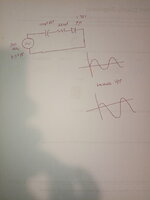umery2k75
Advanced Member level 1
Hello everyone,
I wanted to experiment if I could drive an LED 3mm RED 1.8V forward bias voltage through a capacitor, so I connect function generator on HighZ on 5Vpp 300KHz connect it with different capacitors non-polar and polar and in series with resistor and a LED. All small non-polar capacitors like 0.1uf or 0.01uF shifts down the AC waveform just enough so the LED doesn't turns on, later I experiment with polar capacitor 100uF 25V, I was able to see the LED turning bright but eventually the AC wave shift downs and light intensity lowers down, I increase Vpp slowly then I can see bright light again then light intensity lower down. When I turned my Vpp to my original position 4.5Vpp coming from 10Vpp. I can see LED turns off completely and my majority AC waveforms has shifted down in negative and then I have to remove the capacitor - then short it and put it back again, then it starts to work again. Can anybody shed some light.
Experiment video
I wanted to experiment if I could drive an LED 3mm RED 1.8V forward bias voltage through a capacitor, so I connect function generator on HighZ on 5Vpp 300KHz connect it with different capacitors non-polar and polar and in series with resistor and a LED. All small non-polar capacitors like 0.1uf or 0.01uF shifts down the AC waveform just enough so the LED doesn't turns on, later I experiment with polar capacitor 100uF 25V, I was able to see the LED turning bright but eventually the AC wave shift downs and light intensity lowers down, I increase Vpp slowly then I can see bright light again then light intensity lower down. When I turned my Vpp to my original position 4.5Vpp coming from 10Vpp. I can see LED turns off completely and my majority AC waveforms has shifted down in negative and then I have to remove the capacitor - then short it and put it back again, then it starts to work again. Can anybody shed some light.
Experiment video
